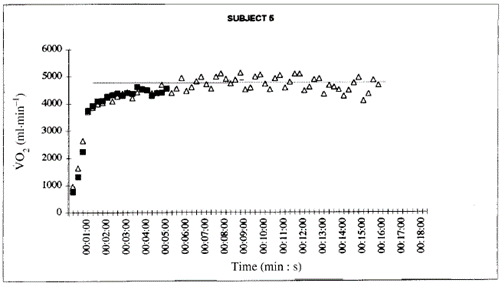In addition to making cool-looking Xert Workout Reports, research has shown that micro-intervals are potent training stimuli. In this blog post, we will dig in a little more to understand exactly why those micro-intervals can be so beneficial to your cycling fitness. We will also look at Xert’s analysis of different styles of micro-intervals and how they compare to longer, constant-power intervals.
Short Interval Benefits
Interval training consists of brief periods of high intensity separated by short periods of recovery. Those of you who have listened to the Xert Breakthrough Lab Podcast will know that we are big fans of the Ronnestad workout, which features short, hard efforts. These “bursty” style of intervals are great for mimicking attacks that are present in road & CX racing. But why do we love these short, hard intervals so much? And why do they provide such a potent training stimulus? To help answer that question, I want to direct us to a research paper published by French physiologist, Veronique Billat. I also want to point out that although the study was completed with runners, the fundamental concept of this research article translates well into cycling.

In the late 90’s, it was well known that intermittent training – such as 30s hard efforts followed by 30s of recovery – was both efficient for improving an athlete’s maximal oxygen uptake (VO2max), as well as being tolerable, even for untrained individuals. However, no study had investigated oxygen utilization during these intervals. In a novel study, Billat and colleagues used a portable metabolic analyzer on a track to see how interval type affected athletes’ oxygen utilization. Let’s take a quick look at the study subjects & methods below:
The researchers recruited eight endurance trained male athletes (34 years old) with a very respectable VO2max of 59 mL/kg/min to perform runs on 3 separate days:
- Run #1: Incremental Test to Exhaustion – analogous to doing a ramp test to determine Threshold Power
- Run #2: Intermittent Run – 30s at an effort equal to 100% VO2max, followed by 30s at an effort equal to 50% VO2max. This pattern continued until exhaustion! In Xert terms, these athletes pushed hard above TP for 30s, rested below TP for 30s, and continued this pattern until they became limited by their MPA.
- Run #3: Continuous Run – athletes were instructed to hold an effort around 90% VO2max until exhaustion was reached. Once again, using Xert terminology, they completed a constant-power effort above Threshold (around 7 minute power) until they were limited by their MPA.
What did the researchers find out?
When looking at the continuous runs, five of the eight runners reached their VO2max and sustained that effort for just under 5 minutes on average. They also reached an average of 96% of maximal heart rate – that’s a painful effort!
But how did that effort compare to the intermittent run? On average, the athletes were able to complete 19 repetitions of the hard intervals, which equates to 9.5 minutes of severe exercise at an intensity equal to VO2max. That’s nearly double what they were able to achieve during the continuous effort! Further, 7 of the 8 runners achieved their VO2max and maintained it for just under 8 minutes, on average. Interestingly, by the 5th interval, researchers saw no significant difference in oxygen consumption between the “on” and “off” efforts, indicating the athletes were near VO2max for the remainder of the interval session.
The researchers created a beautiful overlaid figure that makes it easy to view & interpret these results – check out the figure from the study posted below. The figure displays one athlete’s oxygen consumption on the left axis plotted against the duration of the run on the horizontal axis. In the black dots, you can see this athlete’s continuous running session, while the intermittent run is displayed in the white triangles.

Figure 1. Taken from Billat et al., 2000.
I want to point out a couple of interesting things from this figure. First, this graph makes it easy to see how much more training can be accomplished when utilizing micro-intervals. Although both efforts were completed to exhaustion, the intermittent effort could be sustained far longer. What I find even more interesting is that athletes were able to maintain such a high oxygen consumption throughout the effort. So, not only can these intermittent intervals be sustained for longer, but they also allow athletes to spend a large amount of time near VO2max.
This study compared only two high-intensity sessions, so the authors were unfortunately unable to conclude anything about potential chronic results of intermittent intervals. The researchers’ speculations about short intervals being a superior chronic training stimulus were later confirmed by Dr. Rønnestad’s work. In their 2015 paper, Rønnestad and colleagues demonstrated that 3 weeks of training with short intervals resulted in superior performance improvements when compared to 3 weeks of long-intervals.
Using Xert, we know that accumulating more strain (XSS) will result in larger fitness signature increases.Thus, consistently performing a workout that provides more XSS (compared to a similar workout with less XSS) will, in theory, result in greater fitness improvements. As we will see later in the post, these micro-interval workouts result in higher XSS over the course of a 1 hour workout. Therefore, using Xert’s analysis, we can agree with the conclusion that micro-intervals should result in larger fitness gains.
Xert Analysis of Micro-Intervals
In this section, let us see Xert’s analysis of various styles of micro-intervals and the benefits that they provide! We will also look at moderate, constant-power intervals and see how they stack up! Let’s get into it!
Billat (30-30’s)

Here’s an Xert MPA chart of a Billat-style workout I recently completed. To me, this workout displays the ability to sustain a hard effort for a considerable amount of time – here I was able to sustain approximately 90% of my maximum heart rate for 30 min! This hard effort is detected in Xert via a 5-diamond difficulty rating. You can see the difficulty line shaded grey in the background. You can challenge yourself to this workout yourself by selecting SMART – Test Your Might from the Xert Workout Library.
Rønnestad (30-15’s)

Here we see my MPA analysis of a Rønnestad workout I performed a few weeks ago. According to the original study from Rønnestad’s research group, the athlete’s goal for the workout is to achieve the highest average power across all 3 sets of 13 intervals – they were not given any interval targets! Once again, notice that successfully pulling down MPA throughout the workout results in a high difficulty rating. Challenge yourself on this workout by selecting SMART – A Pain That I’m Used To from the Workout Library.
Tabata (20-10’s)

Tabatas feature a much shorter work:rest duration than the previous two workouts. Here is my MPA analysis of a “Xertified” Tabata workout. From this chart, we can see that MPA isn’t drawn down as far as the previous two workouts, so the difficulty score is a bit lower, along with the total XSS for the workout. You can try the Tabata-style of efforts by selecting the SMART – Valley of the Damned workout. Because these intervals are so short, you will likely experience lag from your Smart Trainer as it works to control your effort level.
Seiler (4 x 8 min)

I wanted to reconnect back to the original research article and include a constant-power effort at a lower intensity for a comparison. Here I performed 4 sets of 8 min efforts at the highest intensity I could manage for all 4 intervals. Notice that my Heart Rate doesn’t reach ~90% of max until several minutes into each effort (and not at all in the final effort). Similar to 30-30’s and 30-15’s, we see a high difficulty score. This high difficulty effort impacted my ability to continue pushing hard on the final interval, which ended up averaging 10 W lower than the first 3 intervals. You can test the “Xertified” version of the Seiler 4×8 workout by selecting the SMART – 4×8 min @ 150XSSR workout from the Xert workout library.
Workout Comparison
In the following table, I have compared the Xert analysis of these three different types of micro-intervals, as well as a constant-power effort. Although each of the three micro-interval workouts featured distinctly different interval patterns, they provided remarkably similar Focus Duration and training strain (XSS). However, when we look at the constant-power effort, we see a significantly longer focus duration. Because these interval durations are so long, they have to be performed at a lower intensity. According to Xert’s analysis, the 4×8 workout would place less strain (XSS) on your HIE system because of the longer focus duration, so it would actually be less beneficial for training your VO2max than a micro-interval workout.
| Workout | Focus Duration & Focus Type | XSS |
|---|---|---|
| SMART – Test Your Might | 4:51 – Breakaway Specialist | 134 |
| SMART – A Pain That I’m Used To | 4:25 – Puncheur | 137 |
| SMART – Valley of the Damned | 4:45 – Breakaway Specialist | 104 |
| SMART – 4×8 min @ 150 XSSR | 18:03 – Sprint Time-Trialist | 103 |
Micro-Intervals and Trainer Modes
If you get the chance to try either the SMART – Test Your Might or SMART – A Pain That I’m Used To Workouts with the Xert EBC app or Garmin Workout Player, you may have noticed that your trainer will not control the micro-intervals efforts for you (ERG mode). That is because these efforts are best performed in SLOPE mode. In SLOPE mode, your smart trainer will hold a fixed resistance level, similar to what you would experience when climbing a steady gradient outdoors. As such, you will need to use your gears & cadence to increase or decrease your effort level. Doing micro-interval efforts in SLOPE mode means you have greater control over your workout, since you can increase or decrease your effort level by simply changing gears. If you’re having a strong day, you can push harder and possibly generate a breakthrough. If you’re not feeling so strong, you can easily decrease your effort.

Summary
The take home message from this blog post is that short, intermittent intervals which alternate between hard and easy efforts, will allow you to maintain relatively high intensities longer than could be achieved with longer, steady-state intervals. Billat and colleagues mentioned that the benefit of high intensity training on aerobic capacity (VO2max) is dependent on the time spent training at VO2max. Thus, they concluded that intermittent training was superior to continuous intervals, since intermittent workout allowed for a greater amount of time spent at VO2max. In Xert, we see that various types of micro-intervals result in a Focus Duration of approximately 5:00, implying that they are potent workouts for increasing your 5-minute power, which is often used as a proxy for VO2max power!
References:
Billat VL, Slawinski J, Bocquet V, Demarle A, Lafitte L, Chassaing P, Koralsztein JP. Intermittent runs at the velocity associated with maximal oxygen uptake enables subjects to remain at maximal oxygen uptake for a longer time than intense but submaximal runs. Eur J Appl Physiol. 2000 Feb;81(3):188-96.
Rønnestad, BR et al. Superior performance improvements in elite cyclists following short-interval vs effort-matched long-interval training. Scand J Med Sci Sports. 30:849-857, 2020.





